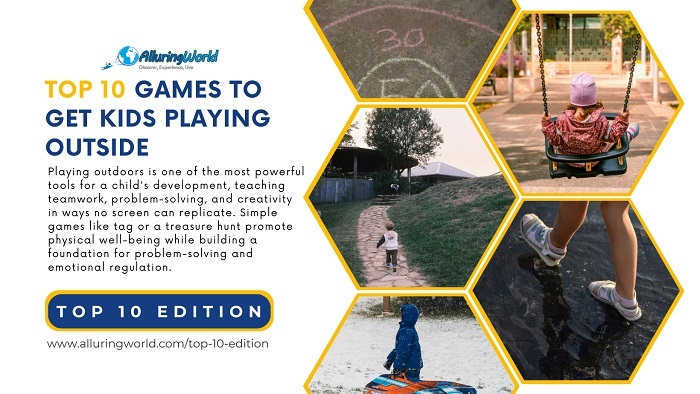Kids nowadays are not very much into outdoor play, although this is one of the most powerful tools for a child’s development. Beyond physical activity, it teaches teamwork, problem-solving, and creativity in ways no screen can replicate. In a natural laboratory, children encounter real-world challenges that build crucial life skills. There are many activities like building a fort or navigating a tricky path, which actually foster critical thinking, while games like tag require them to negotiate rules and manage emotions, developing social and emotional intelligence. The outdoors offers endless opportunities for imaginative play, turning a stick into a magic wand or a patch of dirt into a kitchen, which strengthens their ability to think abstractly. These are better alternatives than having the kids locked inside in front of a screen.
As a parent, you don’t need expensive toys or complicated setups to get your kids engaged; just open space, a little imagination, and your encouragement. The most powerful tools are often the simplest ones. By embracing this approach, you can provide a rich environment that will keep your children active, entertained, and learning valuable skills at the same time. All of these experiences contribute mainly to physical well-being, in addition to building a foundation for problem-solving, emotional regulation, and a lifelong appreciation for the world around them.
1. Encourage a Twist on Tag
Tag never gets old, but you can make it even more exciting by introducing freeze tag or shadow tag. These small changes keep the game fun and dynamic while engaging more kids at once.
Why it works: Mainly because it sharpens reflexes, builds agility, and helps children develop social bonds.
2. Set Up a Treasure Hunt
Hide small objects around the yard or park and give your kids simple clues to track them down. You can even theme it, such as with pirates, nature, or superheroes, which will add to the excitement.
Why it works: Builds problem-solving skills, encourages teamwork, and sparks creativity.
3. Organize Relay Races with Fun Challenges
Instead of plain running, consider adding some obstacles like hopping, balancing spoons, or skipping to make it more engaging for the kids. Even though some kids will laugh their way through while still competing, they will be able to have a great time with this.
Why it works: Promotes teamwork, coordination, and perseverance.
4. Introduce Capture the Flag
Divide the kids into two teams and give each team a colorful flag to protect. Watch how they strategize, cooperate, and run with one purpose as they try to capture the other team’s flag. With the right sneakers, such as the Nike Phoenix, they can play this game at a park or in your backyard.
Why it works: Encourages leadership, planning, and cooperation under pressure.
5. Create a Nature Scavenger Hunt
This is probably the most unique one, as it can be a list of items that can be given to the kids to find in the natural world, like a feather, a unique leaf, or a smooth stone. This turns a simple walk into an adventure.
Why it works: Strengthens observation skills, fosters curiosity, and builds a connection with nature.
6. Try Balloon Toss on Warm Days
This is perfect for those really hot days. Fill balloons with water and have the kids toss them back and forth, while not popping the balloon, stepping farther apart after each successful catch. The suspense of the splash keeps the game thrilling.
Why it works: Improves hand-eye coordination and gives them a refreshing way to stay active outdoors.
7. Build a Backyard Obstacle Course
This requires a little bit of fantasy as it can involve using cones, ropes, chalk, or even chairs to design a course. Let your kids crawl, jump, and zigzag their way through, and challenge them to beat their times. Even adults can join in this outdoorsy game and have quality family bonding time.
Why it works: Develops problem-solving, agility, and physical strength.
8. Reintroduce Kick the Can
Where this classic combines hide-and-seek and tag simultaneously, it is a simple game where kids try to rescue their teammates by kicking the can before being tagged. This definitely is an old favorite that continues to excite kids today.
Why it works: Builds strategy, cooperation, and patience while keeping everyone active.
9. Bring Out Parachute Play (Even Without a Parachute)
This game requires the use of a large blanket, and it lets the kids shake it together to launch lightweight toys or balls into the air. Even though it appears simple, it still requires teamwork to succeed. Attention should be paid to the weight of the objects that will be parachuted, and they should be lightweight ones.
Why it works: Promotes cooperation, rhythm, and collective play.
10. Add Creativity to Hopscotch
Draw the traditional hopscotch grid, but make it playful by adding silly rules like clapping, hopping backward, or spinning in certain squares.
Why it works: Enhances balance, coordination, and creative thinking.
In conclusion, as a parent who is giving your kids opportunities to play outdoors is a gift that strengthens their bodies, minds, and relationships. These 10 simple games require minimal effort to set up but can have a significant impact on your child’s health and happiness. With just a yard, a park, or even a sidewalk, you can transform ordinary spaces into playgrounds for imagination, teamwork, and growth. Sometimes, the simplest games create the best memories.

